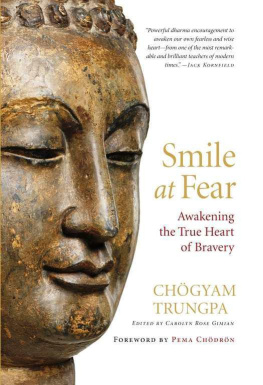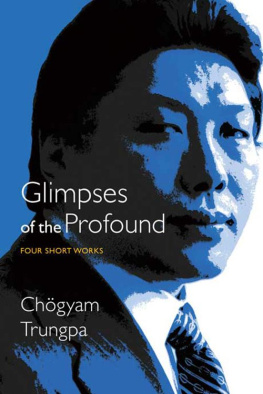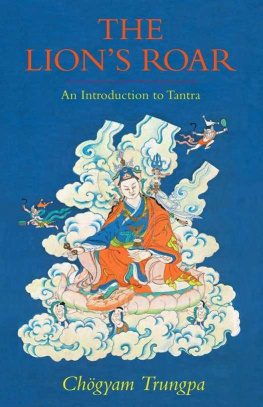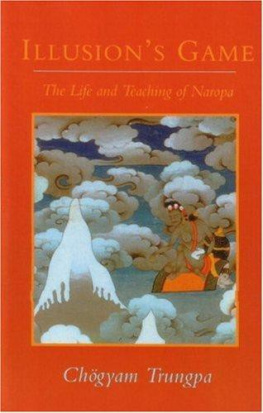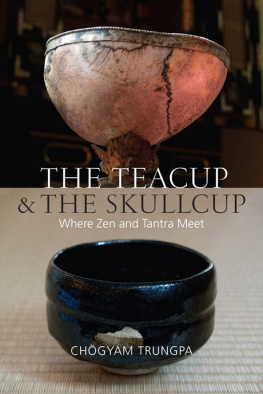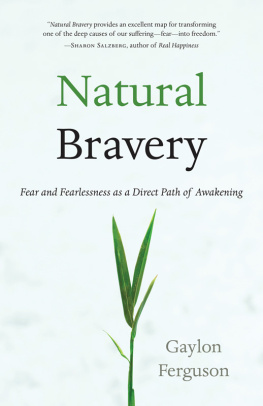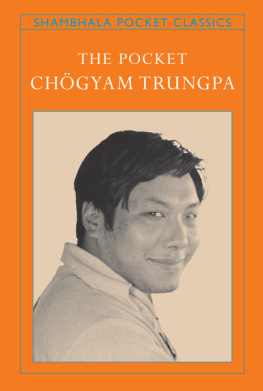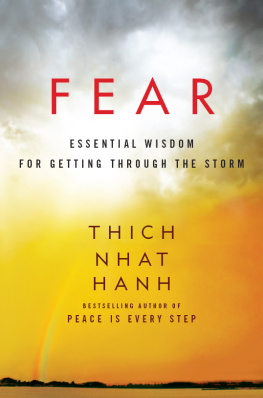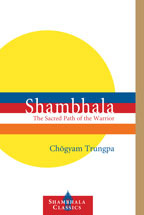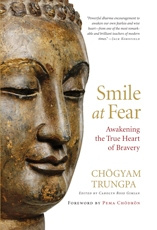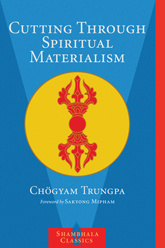Smile at Fear
AWAKENING THE TRUE HEART
OF BRAVERY
Chgyam Trungpa
Edited by Carolyn Rose Gimian
Foreword by Pema Chdrn

Shambhala
Boston & London
2010
Shambhala Publications, Inc. Horticultural Hall 300 Massachusetts Avenue Boston, Massachusetts 02115 www.shambhala.com 2009 by Diana J. Mukpo For further copyright information, see the Sources section. All rights reserved. No part of this book may be reproduced in any form or by any means, electronic or mechanical, including photocopying, recording, or by any information storage and retrieval system, without permission in writing from the publisher. Library of Congress Cataloging-in-Publication Data Trungpa, Chgyam, 19391987. Smile at fear: awakening the true heart of bravery/Chgyam Trungpa; edited by Carolyn Rose Gimian.1st ed. p. cm. Includes index. eISBN 978-0-8348-2148-4 ISBN 978-1-59030-696-3 1. CourageReligious aspectsBuddhism. 2. FearReligious aspectsBuddhism. 3. Religious lifeBuddhism. I. Gimian, Carolyn Rose. II. Title. BQ4570.C78T78 2009 294.35696dc22 2009010128
W HEN YOU ARE FRIGHTENED by something, you have to relate with fear, explore why you are frightened, and develop some sense of conviction. You can actually look at fear. Then fear ceases to be the dominant situation that is going to defeat you. Fear can be conquered. You can be free from fear, if you realize that fear is not the ogre. You can step on fear, and therefore you can attain what is known as fearlessness. But that requires that, when you see fear, you smile.
Chgyam Trungpa, Great Eastern Sun
Contents
Foreword
F OR ME , contemplating the teachings of Chgyam Trungpa is like dipping into a well from which endless wisdom can be drawn. I have been going back to this source for more than thirty years now, and I always find that it contains something to inspire me, to challenge me, and to help me on my path. More than ever, with the great problems that our society and each of us are facing, Trungpa Rinpoches teachings are there to help us.
How is it that the words of someone who passed away more than two decades ago can feel so amazingly fresh, up to date, and applicable to what we are facing at this time? Its not so strange, really, because Rinpoche was always addressing whats happening in this very moment, and that kind of direct, spontaneous teaching never goes out of fashion.
As well, he seemed to know what problems we would face in this millennium. There is so much speed, anxiety, and fearfulness in us and all around us, and this is exactly what he speaks to. We can try to hide, but deep down we know that the only real choice is to embrace and befriend the uncertainty of these times. We really need to do this now we dont have any time to lose.
Chgyam Trungpas way of waking us up is provocative, heartfelt, and delightful. I find that his Shambhala teachings, which are the core of this book, help us to open our hearts and to find real bravery, so that we can extend ourselves to others.
This is based on being vulnerable yet strong. There is a great deal of strength in nonaggression, or peacefully abiding. This is what Rinpoche means by being a Shambhala warrior. I think it is something we all aspire to. As he invites us to do, lets look honestly into ourselves, so that we can be fearless, gentle people.
Pema Chdrn
Editors Preface
T HIS IS A BOOK about all the fears we have, from momentary panic and anxiety, up to the biggest terrors we may face about our life and our death. It is also about the fundamental sources of fear and anxiety, which affect all of us. The author presents practical advice, but not quick fixes. He is trying to help us fundamentally transform our lives and our perceptions so that we can conquer fear, not simply suppress it for a time. To become truly fearless, he suggests, we must stop running from our fear and begin to make friends with it. We must learn to smile at fear. This is a critical part of the conquest.
As I write this preface, we are in the midst of a dramatic economic crisis that is creating shock waves of fear and anxiety around the world. It seems a very appropriate time for a book on working with fear. However, given the human condition and the ongoing chaos in the world, it is probably always a good time to look into the issues of fear and fearlessness.
Chgyam Trungpa, one of the greatest Buddhist teachers of the twentieth century, died in 1987. Yet these teachings on spiritual warriorship and bravery seem as though they were written for this very moment in time. He felt that the West, and indeed the world as a whole, would face immense difficulties in the twenty-first century, and he spoke to his students of those potential hardships with a mixture of confidence and realism. Trungpa Rinpoche (Rinpoche is a title for realized teachers that means Precious One) was sure that humanity could handle what might be coming, but equally sure that the challenges would be substantial. I participated in sobering conversations with him about the economic and political future of North America and other parts of the world.
Rinpoche himself was a man who embodied fearlessness and compassion. In 1950 his homeland of Tibet was invaded by the Chinese Communists, and he was forced to flee the country in 1959 with the knowledge that there was a price on his head. He set off on foot from a remote area in East Tibet to seek refuge in India, leading a group of three hundred Tibetans on a journey that took ten months. Needless to say, they met with extreme challenges and many opportunities to face their fears.
Most of the group was captured in the last months of the journey as they crossed the Brahmaputra River in southern Tibet. Just over fifty of them made it all the way to India. Throughout this journey, Trungpa Rinpoche relied on meditative insight as the basis for his strength and courage, and he never ceased to recommend this approach to others.
After escaping Tibet, sadly, he never saw his mother or any other members of his family again. Yet years later, he expressed his feelings of great compassion for Mao Tse-tung, the revolutionary leader who ordered the invasion of Tibet. In this book he shares the Buddhist teachings that are the basis of this kind of tenderhearted bravery.
Each of us can awaken the same kind of courage in our lives now. What terrifies us doesnt change so much from decade to decade or from one person to another. The fundamental fear we have to work with is the fear of losing ourselves. When the stronghold of ego is threatened, fear is one of our strongest defense mechanisms. Beginning to dismantle it is one of the greatest gifts we can give ourselves or others.
In this volume, Chgyam Trungpa uses the image of the warrior to describe the attitude we can take to invoke fearlessness and bravery in our spiritual practice and in our lives. Rinpoche realized that the secular and the religious would have to be more fully joined in modern spirituality, if spirituality were to truly serve the needs of this time. This is reflected here in his use of the imagery of Shambhala, a mythical country of enlightened citizens ruled by benevolent monarchs. Shambhala is a symbol of the aspiration to build a good society. It also emphasizes the importance of completely engaging with our everyday life. By speaking of the power of the Shambhala world, he is in part pointing to how working with the worldly, ordinary aspects of life can have a transcendent dimension, showing us that the world as it is contains dignity and beauty.
Chgyam Trungpa discusses many levels of working with fear, including how to engage properly with the most extreme situations, such as having to fight an actual enemy, not just an obstacle in your mind. The times we live in seem to call for the kind of gut-level bravery that he exemplified. Having worked with particularly difficult situations in life, he understood reallife challenges. He does not shy away from discussing such situations here. At the same time, he also talks about how each moment can be the opportunity to awaken confidence, through seeing the sacredness of everyday life. This too is a powerful antidote to fear and anxiety. One of the truly remarkable characteristics of his approach is that it steadfastly rejects aggression as a strategy for overcoming obstacles. A deep and powerful well of gentleness is the basis for the bravery of the Shambhala warrior, the practitioner who wants to fully engage life without arrogance or aggression. When we are threatened, it is all too easy to react with anger. When were hit, we want to hit back. Rinpoche shows us alternatives that are powerful without being destructive. This is wisdom we need.
Next page
